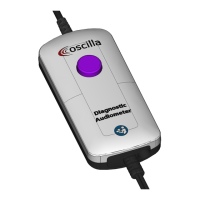
Do you have a question about the OSCILLA A30 and is the answer not in the manual?
| Type | Audiometer |
|---|---|
| Operating Modes | Manual, Automatic |
| Intensity Levels | 5 dB steps |
| Warranty | 2 years |
| Frequency Range (Air) | 125 Hz - 8 kHz |
| Frequency Range (Bone) | 250 Hz - 4000 Hz |
| Intensity Range (Bone) | -10 dB to 70 dB |
| Masking | Narrowband, Speech, White Noise |
| Connectivity | USB |
| Frequency Range | 125 Hz - 8 kHz |
| Compatibility | PC |
Diagnostic audiometric testing for healthcare professionals and patient groups.
Determining hearing loss and protecting patient hearing.
Table showing features vs. configurations for different models.
Step-by-step guide for installing software and connecting the device.
Minimum hardware and supported operating systems for the audiometer.
Identification of PC, USB plug, main unit, headset, and response button.
Meaning of different LED light states: sleep, active, test, and patient button.
Controls for pure tone testing: transducer, curve, stimuli, frequency, and level.
Controls for masking in pure tone operation for A50 & A60 models.
Instructions for connecting the bone conductor to the main unit's right side.
Configuring keyboard shortcuts, frequency selection, and 'not heard' symbol.
Enabling or disabling specific frequencies for audiometric tests.
Settings for startup, mouse cursor, masking, key control, and Weber.
Selecting default automatic tests and configuring notification/saving options.
Adjusting tone lengths, response times, and hearing levels for automatic tests.
Description of 20 dB, 20 dB random, and Hughson Westlake tests.
Adding and editing ear plug types for insulation testing.
Procedure for testing hearing without and with ear protection.
Adjusting level/frequency and selecting tone perception direction.
Understanding SISI test for cochlear pathology and adjusting parameters.
Overview of controls for speech testing with pre-recorded material.
Detailed functions of wordlist, play, score, and level controls.
Controls for speech testing using live voice input.
Explanation of volume meter, score, and level controls.
General and calibration settings for speech tests.
Selecting default speech material and adjusting word intervals.
Standards for device compliance, electrical safety, and EMC.
RETSPL, NBN, and correction values for Oscilla H210A and DD65v2 headsets.
RETSPL, RETVFL, and BC forehead values for bone conduction.
Sound attenuation values for H210A and DD65 earphones.
Operating conditions, storage, transport, dimensions, and accessories.
Details of socket, connector, pin assignment, and input/output specifications.
Guidelines for cleaning the device and recommended cleaning solutions.
Annual calibration and authorized service/repair requirements.
Handling, environment, liquids, flammable gases, and accessory usage.
Restrictions on modifications, PC connections, and using damaged equipment.
Authorized personnel for service, repair, and prohibition of disassembly.
Explanation of symbols like manufacturer, serial number, caution, and medical device.
Compliance with CISPR 11 for RF emissions in professional/domestic environments.
Immunity to ESD, magnetic fields, RF disturbances, and wireless communication.
Contact details and website for Oscilla A/S.
Conditions for manufacturer responsibility regarding safety and performance.